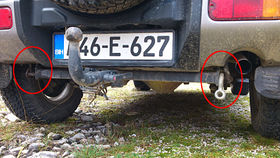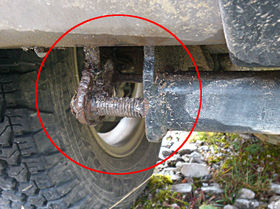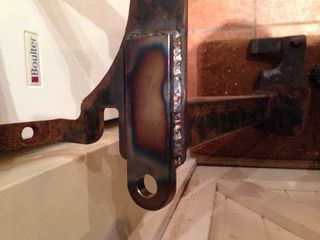![]() The content of any article might be expanded / improved in the future - revisit it sometimes.
The content of any article might be expanded / improved in the future - revisit it sometimes.
![]() Seen a mistake? Know something that isn't written? Edit and change this article yourself!
Seen a mistake? Know something that isn't written? Edit and change this article yourself!
![]() Some images in the article (if present) can be enlarged by clicking on them.
Some images in the article (if present) can be enlarged by clicking on them.
Contents
Introduction
If you intend to go off road, there is a good chance that you will get stuck no matter how equipped your vehicle is, or how "sensibly" you intend to venture.
Therefore, you should invest in strong recovery points.
If you don't, and a factory tow point breaks, you will have to use money as a recovery point, but it needs to be a thick stash of bills to endure the load!
Factory tow and recovery points
Unfortunately, Suzuki does not make recovery points for Jimnys.
The factory fitted front and rear tow points are meant only for that - to tow the vehicle on the road or to tie it down to a platform which is transporting it.
Those factory front and rear tow points are not suitable for recovering a stuck Jimny off road, especially if the pulling direction is sideways.
The only exceptions might be if the vehicle is rather lightly stuck (some snow or some sand). But then some shoveling might be completely sufficient.
If the vehicle is bogged down in snow or sand, or especially in mud, those factory tow points must not be used. They can easily break off when pulling.
If the vehicle has a tow bar, the tow ball must not be used as an anchoring point for vehicle recovery!! Read the wiki article "Tow bar" for more information.
If the vehicle has a front or rear bull bar (nudge bar), don't be an utter idiot and try to use it as an anchor for towing, let alone for vehicle recovery! Read the wiki article "Bull bar (nudge bar)" for more information.
![]() It can be VERY dangerous if a recovery point breaks off during pulling, as it becomes a lethal flying missile!!
It can be VERY dangerous if a recovery point breaks off during pulling, as it becomes a lethal flying missile!!
![]() Mud has incredible stick-on and suction effect, which multiplies the force required to "unstuck" a vehicle (up to 5x vehicle's weight is not unusual).
Mud has incredible stick-on and suction effect, which multiplies the force required to "unstuck" a vehicle (up to 5x vehicle's weight is not unusual).
![]() You don't believe it?
You don't believe it?
Stand ankle-deep in a mud bog and try to walk out of it! That's like when a vehicle is wheel-rim deep in mud.
If you managed to walk out of it, now try it again, but this time balls deep! That's like when a vehicle is bogged down to the floor.
Using recovery points
Introduction
Using omega shackles rated at 3,25 T WLL (working load limit) should be sufficient for Jimny, especially when the load is divided between two recovery points.
Using recovery points in pairs
If you use just one recovery point, you double the risk to rip off your recovery point, or bend the chassis rail if the lone recovery point is indeed so strong!
Therefore, it is very recommended to have two front recovery points and two rear recovery points (one on the left side and one on the right side).
When you have two front and two rear recovery points, then you can (and should) use an "equalizer strap" to transversely connect the left and right recovery point either when towing/pulling or being towed/pulled. The equalizer strap should be at least 2 m long.
Then connect the main strap or rope to the equalizer strap, and the other vehicle to the main strap.
This divides the load on each of the two recovery points, significantly reducing the risk of either a point breaking off, or bending a single chassis rail.
Installing recovery points
Introduction
You can either weld on some DIY reinforcements to the existing front and rear factory tow points (and put your amateur trust into them), or install aftermarket-made heavy-duty recovery points.
Aftermarket-made front recovery points
There there are only a couple of professionally manufactured aftermarket front recovery points for Jimnys.
This chapter lacks details and user experiences with each specific product, so investigate on your own.
Product A
Here is a German report of installation of an aftermarket front recovery point made in Japan.
Aftermarket-made rear recovery points
There there are only a couple of professionally manufactured aftermarket rear recovery points for Jimnys.
This chapter lacks details and user experiences with each specific product, so investigate on your own.
DIY front recovery points
This chapter lacks user experiences. Add your own if you have some! Put them in a dedicated subchapter.
Next person's solution
Write about your experience in this subchapter.
DIY rear recovery points
Bosanek's solution
Forum user Bosanek made his own DIY rear recovery points.
The idea is to weld a short steel rod between the tow bar and the existing factory rear tow point. This way, the load bearing capacity of the tow bar and the tow point would be combined.
Then that rod can be used as a base for attaching a bow shackle or a hook.
The rod should be as as thick as possible (at least 12 mm diameter, but 16-24 mm is much better).
Some tow bars are hollow, thus enabling you to actually insert the rod into the tow bar from the side. This makes an even better strongpoint and eliminates the need to weld the rod to the tow bar.
It would be advisable to also weld another smaller supporting rod between the tow bar and the tow point, behind your "main" rod (visible in 2nd and 3rd pictures below). This supporting rod would increase the bond between the tow bar and the tow point, especially when the pulling direction is sideways. Beware that this supporting rod must not restrict the movement of the bow shackle when attached to the main rod.
The tow bar model in Bosanek's case is very close to the right tow point (other tow bars might not have that issue). There is not enough interspace to put a bow shackle or a hook between the tow bar and the right tow point.
The solution was to forcefully bend the right tow point out of the way just to make enough space to put a bow shackle in between, and to enable the bow shackle to pivot freely. Then a short rod together with the bow shackle was stuck in between, and the rod was welded to the tow point and to the tow bar. The bow shackle is now permanently "stuck" in there. It can pivot freely but there is not enough room to remove it (visible in 4th and 5th pictures below). It is a compromise solution but the best in the circumstances.
All this is much better perceived in the image gallery below. Sorry for not cleaning the vehicle for posing!
![]() To learn more about installing and using a tow bar, read the wiki article "Tow bar"
To learn more about installing and using a tow bar, read the wiki article "Tow bar"
Person B's solution
The two pictures below were downloaded a long time a ago from the Internet. The source has been forgotten. See them for yourself and make your own conclusions.
Person C's solution
A German guy installed this rear recovery point.
Next person's DIY solution
If someone else also has a DIY experience on this subject, write it here in the next subchapter.
Page last edited on 21/02/2019 by user Bosanek







